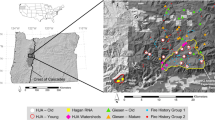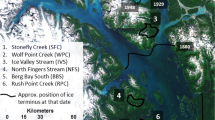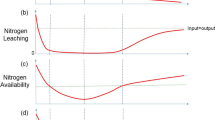Abstract
Stable isotope ratios of terrestrial ecosystem nitrogen (N) pools reflect internal processes and input–output balances. Disturbance generally increases N cycling and loss, yet few studies have examined ecosystem δ15N over a disturbance-recovery sequence. We used a chronosequence approach to examine N distribution and δ15N during forest regrowth after agricultural abandonment. Site ages ranged from 10 to 115 years, with similar soils, climate, land-use history, and overstory vegetation (white pine Pinus strobus). Foliar N and δ15N decreased as stands aged, consistent with a progressive tightening of the N cycle during forest regrowth on agricultural lands. Over time, foliar δ15N became more negative, indicating increased fractionation along the mineralization–mycorrhizal–plant uptake pathway. Total ecosystem N was constant across the chronosequence, but substantial internal N redistribution occurred from the mineral soil to plants and litter over 115 years (>25% of ecosystem N or 1,610 kg ha−1). Temporal trends in soil δ15N generally reflected a redistribution of depleted N from the mineral soil to the develo** O horizon. Although plants and soil δ15N are coupled over millennial time scales of ecosystem development, our observed divergence between plants and soil suggests that they can be uncoupled during the disturbance-regrowth sequence. The approximate 2‰ decrease in ecosystem δ15N over the century scale suggests significant incorporation of atmospheric N, which was not detected by traditional ecosystem N accounting. Consideration of temporal trends and disturbance legacies can improve our understanding of the influence of broader factors such as climate or N deposition on ecosystem N balances and δ15N.







Similar content being viewed by others
References
Amundson R, Austin AT, Schuur EAG, Yoo K, Matzek V, Kendall C, Uebersax A, Brenner D, Baisden WT. 2002. Global patterns of the isotopic composition of soil and plant nitrogen. Glob Biogeochem Cycles 17:1031–1042
Austin AT, Vitousek PM. 1998. Nutrient dynamics on a precipitation gradient in Hawaii. Oecologia 113:519–529
Baisden WT, Amundson R, Cook AC, Brenner DL. 2002. Turnover and storage of C and N in five density fractions from California annual grassland surface soils. Glob Biogeochem Cycles 16:1117–1133
Billings SA, Richter DD. 2005. Changes in stable isotopic signatures of soil nitrogen and carbon during 40 years of forest development. Oecologia 148:325–333
Binkley D, Son Y, Valentine DW. 2000. Do forests receive occult inputs of nitrogen? Ecosystems 3:321–331
Bormann FH, Likens GE. 1994. Pattern and process in a forested ecosystem. Springer, New York
Bowen JL, Valiela I. 2001. Historical changes in atmospheric nitrogen deposition to Cape Cod, Massachusetts, USA. Atmos Environ 35:1039–1051
Brenner DL, Amundson R, Baisden WT, Kendall C, Harden J. 2001. Soil N and 15N variation with time in a California annual grassland ecosystem. Geochim Cosmochim Acta 65:4171–4186
Chang SX, Handley LL. 2000. Site history affects soil and plant 15N natural abundances (δ15N) in forests of northern Vancouver Island, British Columbia. Funct Ecol 14:273–280
Cole DW, Rapp M. 1981. Elemental cycling in forest ecosystems. In: Reichle DE, Ed. Dynamic properties of forest ecosystems, vol 23. Cambridge: Cambridge University Press, pp 341–409
Compton JE, Boone RD. 2000. Long-term impacts of agriculture on soil carbon and nitrogen in New England forests. Ecology 81:2314–2330
Connin SL, Feng X, Virginia RA. 2001. Isotopic discrimination during long-term decomposition in an arid land ecosystem. Soil Biol Biochem 33:41–51
Crews TE, Kitayama K, Fownes JH, Riley RH, Herbert DA, Mueller-Dombois D, Vitousek PM. 1995. Changes in soil phosphorus fraction and ecosystem dynamics across a long chronosequence in Hawaii. Ecology 76:1407–1424
Currie WS, Aber JD, McDowell WH, Boone RD, Magill AH. 1996. Vertical transport of dissolved organic C and N under long-term N amendments in pine and hardwood forests. Biogeochemistry 35:471–505
Emmerton KS, Callaghan TV, Jones HE, Leake JR, Michelsen A, Read DJ. 2001. Assimilation and isotopic fractionation of nitrogen by mycorrhizal and nonmycorrhizal subarctic plants. New Phytol 151:513–524
Evans RD. 2001. Physiological mechanisms influencing plant nitrogen isotope composition. Trends Plant Sci 6:121–126
Garten CT, Van Miegroet H. 1994. Relationships between soil nitrogen dynamics and natural 15N abundance in plant foliage from Great Smoky Mountains National Park. Can J For Res 24:1636–1645
Hobbie EA, Colpaert JV. 2003. Nitrogen availability and colonization by mycorrhizal fungi correlate with nitrogen isotope patterns in plants. New Phytol 157:115–126
Hobbie EA, Jumpponen A, Trappe J. 2005. Foliar and fungal 15N:14N ratios reflect development of mycorrhizae and nitrogen supply during primary succession: testing analytical models. Oecologia 146: 258–268
Hobbie EA, Macko SA, Shugart HH. 1998. Patterns in N dynamics and N isotopes during primary succession in Glacier Bay. Chem Geol 152:3–11
Hobbie E.E, Macko SA, Williams M. 2000. Correlations between foliar δ15N and nitrogen concentrations may indicate plant–mycorrhizal interactions. Oecologia 122:353–360
Högberg P. 1997. 15N natural abundance in soil–plant systems. New Phytol 137:179–203
Högberg P, Högbom H, Schinkel H, Högberg M, Johannisson C, Wallmark H. 1996. 15N abundance of surface soils, roots and mycorrhizas in profiles of European forest soils. Oecologia 108:207–214
Högberg P, Högberg MN, Quist ME, Ekblad A, Nasholm T. 1999. Nitrogen isotope fractionation during nitrogen uptake by ectomycorrhizal and non-mycorrhizal Pinus sylvestris. New Phytol 142:567–576
Homann PS, Bormann BT, Boyle JR. 2001. Detecting treatment differences in soil carbon and nitrogen resulting from forest manipulations. Soil Sci Soc Am J 65:463–469
Hooker TD, Compton JE. 2003. Forest ecosystem C and N accumulation during the first century after agricultural abandonment. Ecol Appl 13:299–313
Houlton BZ, Sigman DM, Hedin LO. 2006. Isotopic evidence for large gaseous nitrogen losses from tropical rainforests. Proc Natl Acad Sci 103:8745–8750
Kronzucker HK, Siddiqi MY, Glass DM. 1997. Conifer root discrimination against soil nitrate and the ecology of forest succession. Nature 385:59–61
Magill AH, Aber JD, Hendricks JJ, Bowden RD, Melillo JM, Steudler PA. 1997. Biogeochemical response of forest ecosystems to simulated chronic nitrogen deposition. Ecol Appl 7:402–415
Melillo JM, Aber JD, Linkins AE, Ricca A, Fry B, Nadelhoffer KJ. 1989. Carbon and nitrogen dynamics along the decay continuum: plant litter to soil organic matter. Plant Soil 115:189–198
Michelsen A, Schmidt IK, Jonasson S, Quarmby C, Sleep D. 1996. Leaf 15N abundance of subarctic plants provides field evidence that ericoid, ectomycorrhizal and non- and arbuscular mycorrhizal species access different sources of soil nitrogen. Oecologia 105:53–63
Nadelhoffer KJ, Fry B. 1988. Controls on natural nitrogen-15 and carbon-13 abundance in forest soil organic matter. Soil Sci Soc Am J 52:1633–1640
Ollinger SV, Aber JD, Lovett GM, Millham SE, Lathrop RG, Ellis JM. 1993. A spatial model of atmospheric deposition for the northeastern U.S. Ecol Appl 3:459–472
Pardo LH, Hemond HF, Montoya JP, Fahey TJ, Siccama TG. 2002. Response of the natural abundance of 15N in forest soils and foliage to high nitrate loss following clearcutting. Can J For Res 32:1126–1136
Pardo LH, Kendall C, Pett-Ridge J, Chang CCY. 2004. Evaluating the source of streamwater nitrate using δ15N and δ18O in nitrate in two watersheds in New Hampshire, USA. Hydrol Proc 18:2699–2712
Perakis SS, Kellogg CH. 2007. Imprint of oaks on nitrogen availability and δ15N in California grassland-savanna: a case of enhanced N inputs? Plant Ecol 191:209–220
Piccolo MC, Neill C, Melillo JM. 1996. 15N natural abundance in forest and pasture soils of the Brazilian Amazon Basin. Plant Soil 182:249–258
Rector DD. 1981. Soil survey of Rhode Island. United State Department of Agriculture, Soil Conservation Service
Richter DD, Markewitz D, Heine PR, ** V, Raikes J, Tian K, Wells CG. 2000. Legacies of agriculture and forest regrowth in the nitrogen of old-field soils. For Ecol Manage 138:233–248
Schmidt EL, Belser LW. 1994. Autotrophic nitrifying bacteria. In RW Weaver, ed. Methods of soil analysis, Part 2. Microbiological and biochemical properties. Soil Science Society of America, Madison, pp 159–177
Schulze E-D, Chapin FS III, Gebauer G. 1994. Nitrogen nutrition and isotope differences among life forms at the northern treeline of Alaska. Oecologia 100:406–412
Schuur EAG, Matson PA. 2001. Net primary productivity and nutrient cycling across a mesic to wet precipitation gradient in Hawaiin montaine rainforest. Oecologia 128:431–442
Shearer G, Kohl DH. 1986. N2-fixation in field settings: estimations based on natural 15N abundance. Aus J Plant Physiol 13:699–756
Smith SE, Read DJ. 1997. Mycorrhizal symbioses. Academic, San Diego
Sollins P, Swanston C, Kleber M, Filley T, Kramer M, Crow S, Caldwell B, Lajtha K, Bowden R. 2006. Organic C and N stabilization in a forest soils: evidence from sequential density fractionation. Soil Biol Biochem 38:3313–3324
Visser S. 1995. Ectomycorrhizal succession in jack pine stands following wildfire. New Phytol 129:389–401
Vitousek PM, Reiners WA. 1975. Ecosystem succession and nutrient retention: a hypothesis. BioScience 25:376–381
Vitousek PM, Shearer G, Kohl DH. 1989. Foliar 15N natural abundance in Hawaiian rainforest: patterns and possible mechanisms. Oecologia 78:383–388
Woodward FI, Osborne CP. 2000. The representation of root processes in models addressing the responses of vegetation to global change. New Phytol 147:223–232
Acknowledgments
The authors thank José Amador, Keith Killingbeck, Bob McKane, and Michelle Mack for helpful discussions of this work. Comments from Helga Van Miegroet, Amy Austin and two anonymous reviewers greatly improved the manuscript. Michael Capircchio, Kate Ensor, Jeremy Tremblay and Sara Manocchia provided lab and field assistance, and Bill Griffis and Christine Redmond conducted isotope analyses. We are grateful to the Providence Water Supply Board for site access and information on land-use history. This document has been approved for publication by the US EPA. Mention of trade names does not constitute endorsement. This work was supported by USDA (CSREES Grant #97–35106-4803), US EPA and the Rhode Island Agricultural Experiment Station.
Author information
Authors and Affiliations
Corresponding author
Electronic supplementary material
Below is the link to the electronic supplementary material.
Rights and permissions
About this article
Cite this article
Compton, J.E., Hooker, T.D. & Perakis, S.S. Ecosystem N Distribution and δ15N during a Century of Forest Regrowth after Agricultural Abandonment. Ecosystems 10, 1197–1208 (2007). https://doi.org/10.1007/s10021-007-9087-y
Received:
Revised:
Accepted:
Published:
Issue Date:
DOI: https://doi.org/10.1007/s10021-007-9087-y




